Global Environment Report: Friedman's Views and Corporate Culture
VerifiedAdded on 2021/05/30
|8
|1643
|171
Report
AI Summary
This report provides an analysis of the global environment, focusing on globalization, corporate culture, and strategic alignment. It examines Thomas Friedman's views on globalization, including the concept of a "flat world" and its implications, as well as the risks and drawbacks associated with it. The report also explores the uniformity of globalization across the world. Furthermore, it delves into corporate culture and strategy, using examples of different culture types like adhocracy and market cultures. The report then evaluates the alignment between corporate culture and strategy, emphasizing the importance of their fit for organizational success. The conclusion highlights the key takeaways from the e-learning activities, including the impact of globalization on different regions and the significance of aligned strategies in an organization. References are also provided for the report.
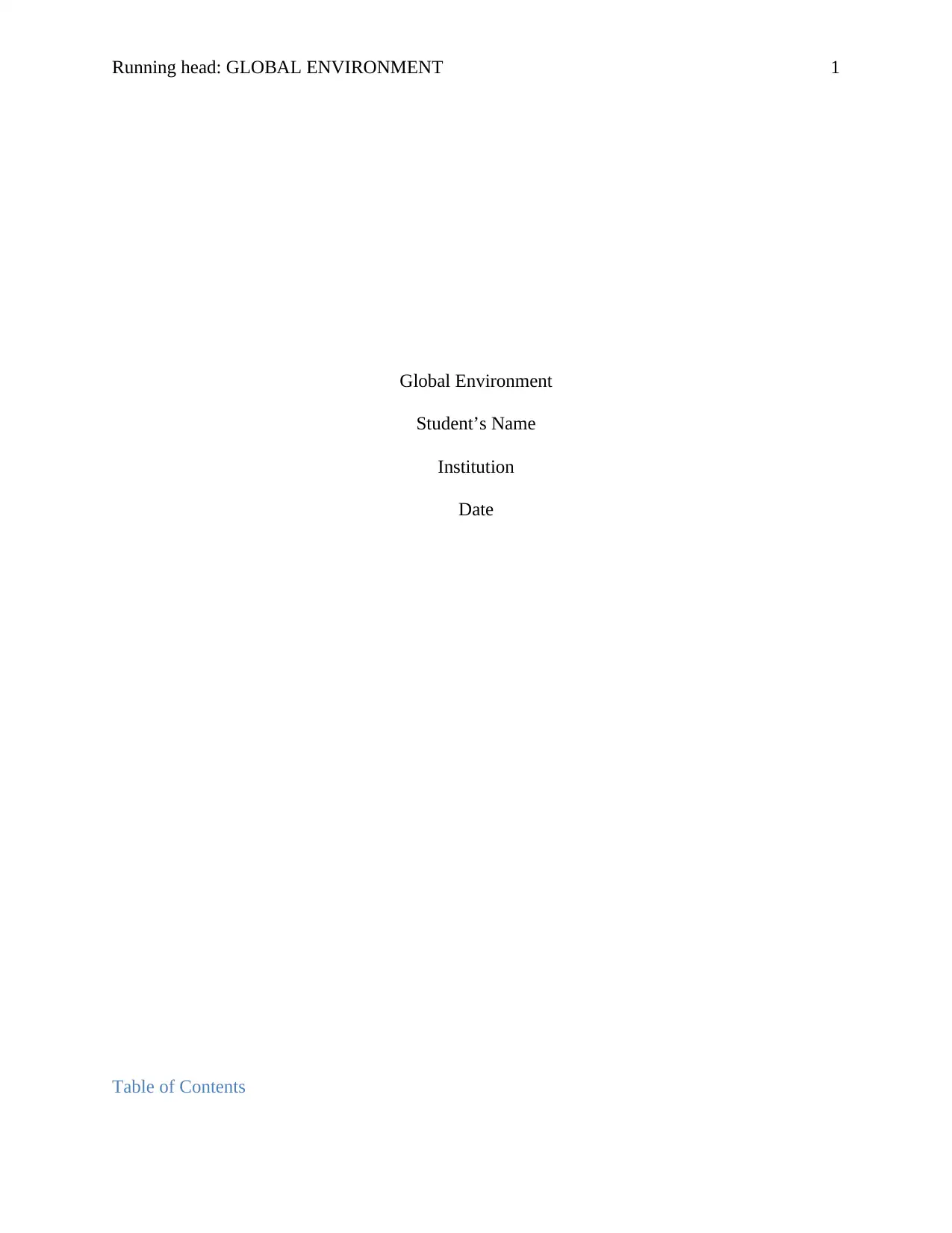
Running head: GLOBAL ENVIRONMENT 1
Global Environment
Student’s Name
Institution
Date
Table of Contents
Global Environment
Student’s Name
Institution
Date
Table of Contents
Paraphrase This Document
Need a fresh take? Get an instant paraphrase of this document with our AI Paraphraser
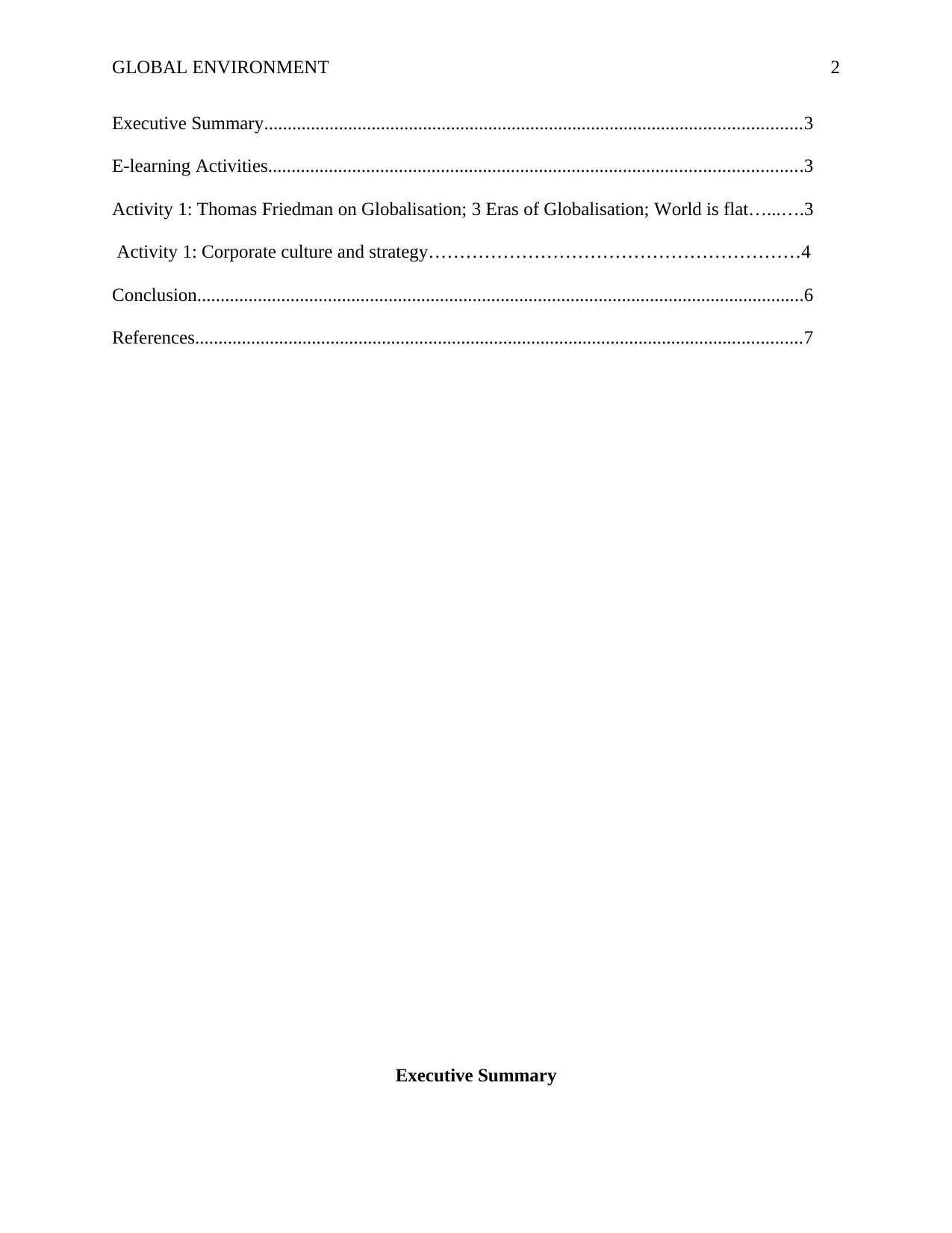
GLOBAL ENVIRONMENT 2
Executive Summary...................................................................................................................3
E-learning Activities..................................................................................................................3
Activity 1: Thomas Friedman on Globalisation; 3 Eras of Globalisation; World is flat…...….3
Activity 1: Corporate culture and strategy……………………………………………………4
Conclusion..................................................................................................................................6
References..................................................................................................................................7
Executive Summary
Executive Summary...................................................................................................................3
E-learning Activities..................................................................................................................3
Activity 1: Thomas Friedman on Globalisation; 3 Eras of Globalisation; World is flat…...….3
Activity 1: Corporate culture and strategy……………………………………………………4
Conclusion..................................................................................................................................6
References..................................................................................................................................7
Executive Summary
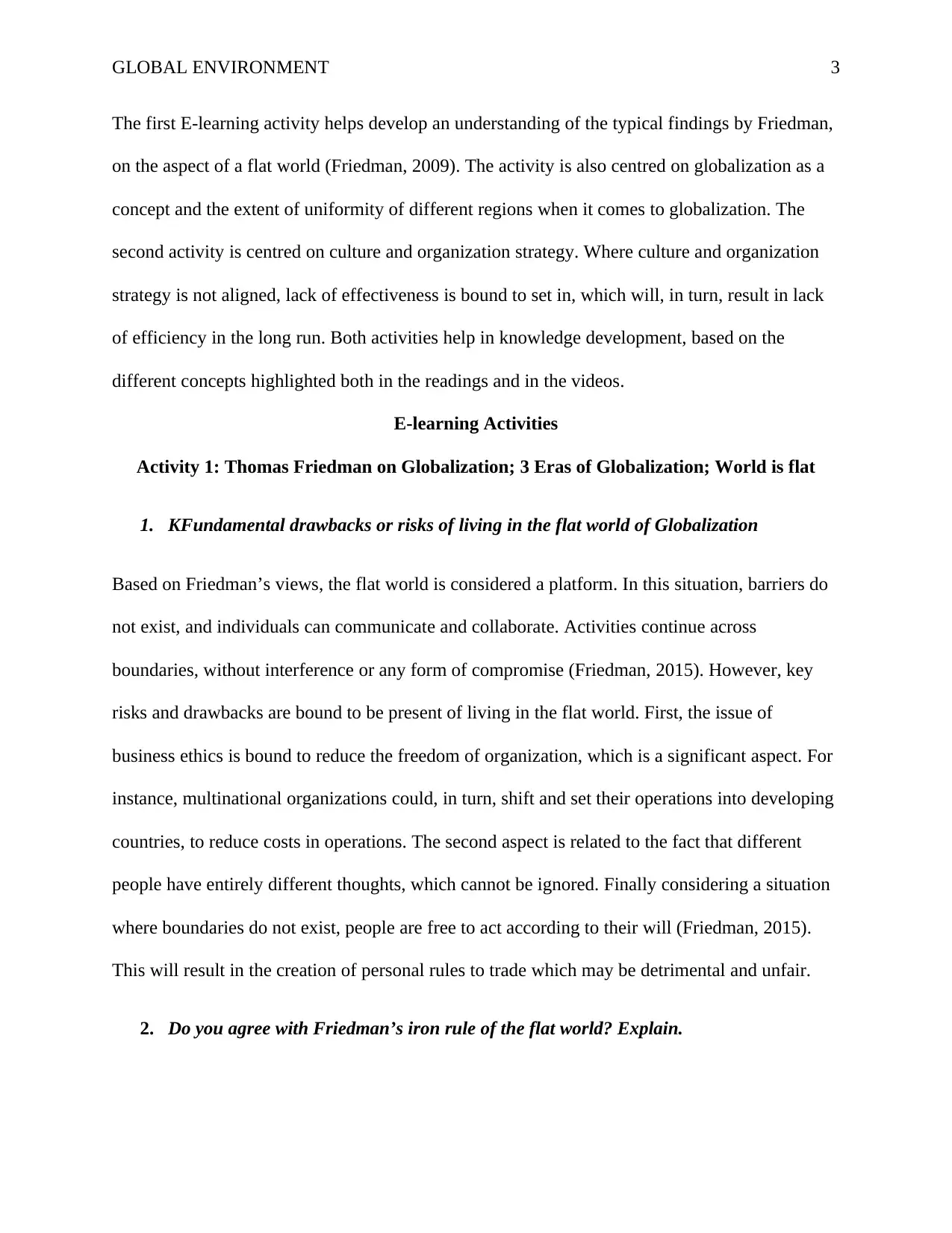
GLOBAL ENVIRONMENT 3
The first E-learning activity helps develop an understanding of the typical findings by Friedman,
on the aspect of a flat world (Friedman, 2009). The activity is also centred on globalization as a
concept and the extent of uniformity of different regions when it comes to globalization. The
second activity is centred on culture and organization strategy. Where culture and organization
strategy is not aligned, lack of effectiveness is bound to set in, which will, in turn, result in lack
of efficiency in the long run. Both activities help in knowledge development, based on the
different concepts highlighted both in the readings and in the videos.
E-learning Activities
Activity 1: Thomas Friedman on Globalization; 3 Eras of Globalization; World is flat
1. KFundamental drawbacks or risks of living in the flat world of Globalization
Based on Friedman’s views, the flat world is considered a platform. In this situation, barriers do
not exist, and individuals can communicate and collaborate. Activities continue across
boundaries, without interference or any form of compromise (Friedman, 2015). However, key
risks and drawbacks are bound to be present of living in the flat world. First, the issue of
business ethics is bound to reduce the freedom of organization, which is a significant aspect. For
instance, multinational organizations could, in turn, shift and set their operations into developing
countries, to reduce costs in operations. The second aspect is related to the fact that different
people have entirely different thoughts, which cannot be ignored. Finally considering a situation
where boundaries do not exist, people are free to act according to their will (Friedman, 2015).
This will result in the creation of personal rules to trade which may be detrimental and unfair.
2. Do you agree with Friedman’s iron rule of the flat world? Explain.
The first E-learning activity helps develop an understanding of the typical findings by Friedman,
on the aspect of a flat world (Friedman, 2009). The activity is also centred on globalization as a
concept and the extent of uniformity of different regions when it comes to globalization. The
second activity is centred on culture and organization strategy. Where culture and organization
strategy is not aligned, lack of effectiveness is bound to set in, which will, in turn, result in lack
of efficiency in the long run. Both activities help in knowledge development, based on the
different concepts highlighted both in the readings and in the videos.
E-learning Activities
Activity 1: Thomas Friedman on Globalization; 3 Eras of Globalization; World is flat
1. KFundamental drawbacks or risks of living in the flat world of Globalization
Based on Friedman’s views, the flat world is considered a platform. In this situation, barriers do
not exist, and individuals can communicate and collaborate. Activities continue across
boundaries, without interference or any form of compromise (Friedman, 2015). However, key
risks and drawbacks are bound to be present of living in the flat world. First, the issue of
business ethics is bound to reduce the freedom of organization, which is a significant aspect. For
instance, multinational organizations could, in turn, shift and set their operations into developing
countries, to reduce costs in operations. The second aspect is related to the fact that different
people have entirely different thoughts, which cannot be ignored. Finally considering a situation
where boundaries do not exist, people are free to act according to their will (Friedman, 2015).
This will result in the creation of personal rules to trade which may be detrimental and unfair.
2. Do you agree with Friedman’s iron rule of the flat world? Explain.
⊘ This is a preview!⊘
Do you want full access?
Subscribe today to unlock all pages.

Trusted by 1+ million students worldwide
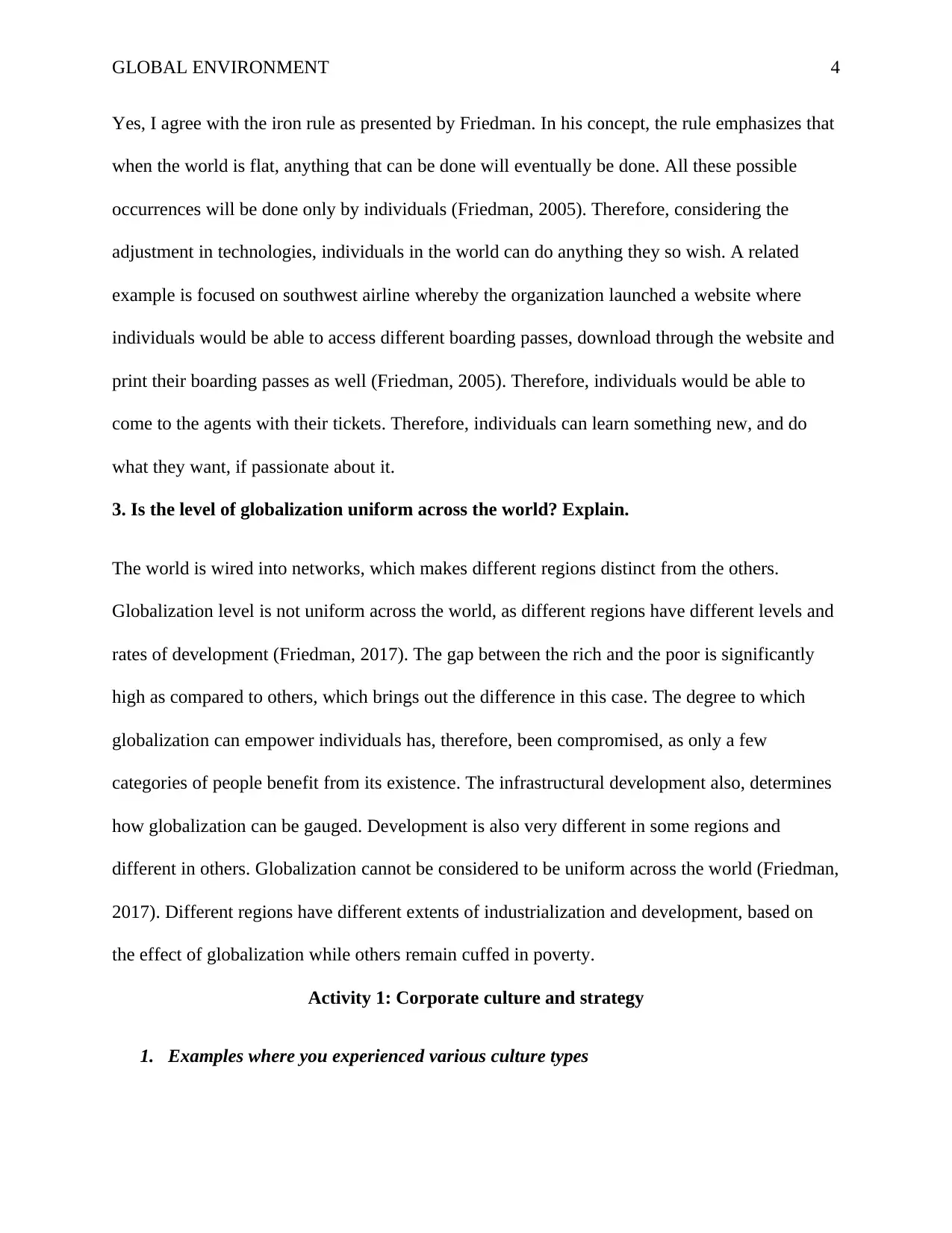
GLOBAL ENVIRONMENT 4
Yes, I agree with the iron rule as presented by Friedman. In his concept, the rule emphasizes that
when the world is flat, anything that can be done will eventually be done. All these possible
occurrences will be done only by individuals (Friedman, 2005). Therefore, considering the
adjustment in technologies, individuals in the world can do anything they so wish. A related
example is focused on southwest airline whereby the organization launched a website where
individuals would be able to access different boarding passes, download through the website and
print their boarding passes as well (Friedman, 2005). Therefore, individuals would be able to
come to the agents with their tickets. Therefore, individuals can learn something new, and do
what they want, if passionate about it.
3. Is the level of globalization uniform across the world? Explain.
The world is wired into networks, which makes different regions distinct from the others.
Globalization level is not uniform across the world, as different regions have different levels and
rates of development (Friedman, 2017). The gap between the rich and the poor is significantly
high as compared to others, which brings out the difference in this case. The degree to which
globalization can empower individuals has, therefore, been compromised, as only a few
categories of people benefit from its existence. The infrastructural development also, determines
how globalization can be gauged. Development is also very different in some regions and
different in others. Globalization cannot be considered to be uniform across the world (Friedman,
2017). Different regions have different extents of industrialization and development, based on
the effect of globalization while others remain cuffed in poverty.
Activity 1: Corporate culture and strategy
1. Examples where you experienced various culture types
Yes, I agree with the iron rule as presented by Friedman. In his concept, the rule emphasizes that
when the world is flat, anything that can be done will eventually be done. All these possible
occurrences will be done only by individuals (Friedman, 2005). Therefore, considering the
adjustment in technologies, individuals in the world can do anything they so wish. A related
example is focused on southwest airline whereby the organization launched a website where
individuals would be able to access different boarding passes, download through the website and
print their boarding passes as well (Friedman, 2005). Therefore, individuals would be able to
come to the agents with their tickets. Therefore, individuals can learn something new, and do
what they want, if passionate about it.
3. Is the level of globalization uniform across the world? Explain.
The world is wired into networks, which makes different regions distinct from the others.
Globalization level is not uniform across the world, as different regions have different levels and
rates of development (Friedman, 2017). The gap between the rich and the poor is significantly
high as compared to others, which brings out the difference in this case. The degree to which
globalization can empower individuals has, therefore, been compromised, as only a few
categories of people benefit from its existence. The infrastructural development also, determines
how globalization can be gauged. Development is also very different in some regions and
different in others. Globalization cannot be considered to be uniform across the world (Friedman,
2017). Different regions have different extents of industrialization and development, based on
the effect of globalization while others remain cuffed in poverty.
Activity 1: Corporate culture and strategy
1. Examples where you experienced various culture types
Paraphrase This Document
Need a fresh take? Get an instant paraphrase of this document with our AI Paraphraser
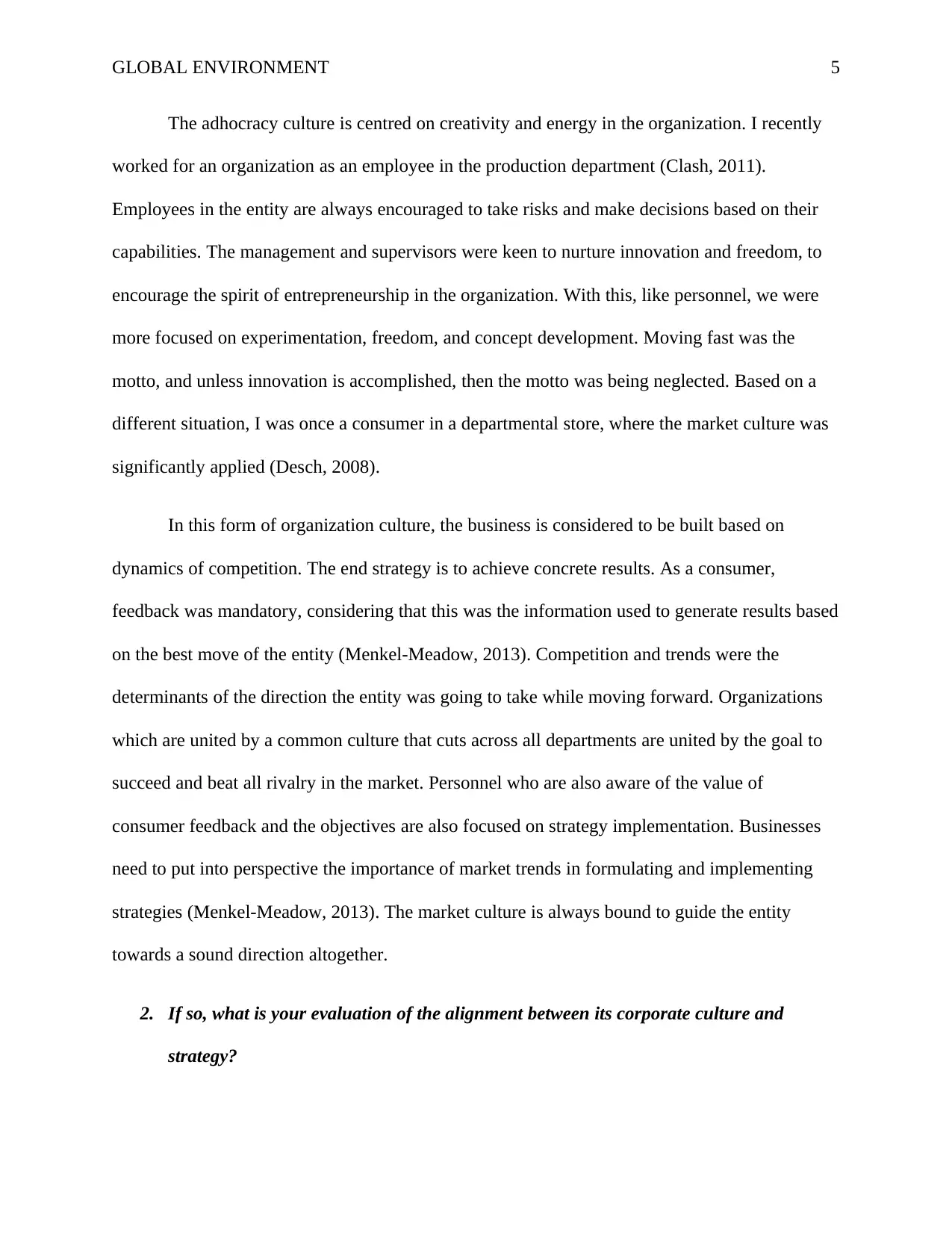
GLOBAL ENVIRONMENT 5
The adhocracy culture is centred on creativity and energy in the organization. I recently
worked for an organization as an employee in the production department (Clash, 2011).
Employees in the entity are always encouraged to take risks and make decisions based on their
capabilities. The management and supervisors were keen to nurture innovation and freedom, to
encourage the spirit of entrepreneurship in the organization. With this, like personnel, we were
more focused on experimentation, freedom, and concept development. Moving fast was the
motto, and unless innovation is accomplished, then the motto was being neglected. Based on a
different situation, I was once a consumer in a departmental store, where the market culture was
significantly applied (Desch, 2008).
In this form of organization culture, the business is considered to be built based on
dynamics of competition. The end strategy is to achieve concrete results. As a consumer,
feedback was mandatory, considering that this was the information used to generate results based
on the best move of the entity (Menkel-Meadow, 2013). Competition and trends were the
determinants of the direction the entity was going to take while moving forward. Organizations
which are united by a common culture that cuts across all departments are united by the goal to
succeed and beat all rivalry in the market. Personnel who are also aware of the value of
consumer feedback and the objectives are also focused on strategy implementation. Businesses
need to put into perspective the importance of market trends in formulating and implementing
strategies (Menkel-Meadow, 2013). The market culture is always bound to guide the entity
towards a sound direction altogether.
2. If so, what is your evaluation of the alignment between its corporate culture and
strategy?
The adhocracy culture is centred on creativity and energy in the organization. I recently
worked for an organization as an employee in the production department (Clash, 2011).
Employees in the entity are always encouraged to take risks and make decisions based on their
capabilities. The management and supervisors were keen to nurture innovation and freedom, to
encourage the spirit of entrepreneurship in the organization. With this, like personnel, we were
more focused on experimentation, freedom, and concept development. Moving fast was the
motto, and unless innovation is accomplished, then the motto was being neglected. Based on a
different situation, I was once a consumer in a departmental store, where the market culture was
significantly applied (Desch, 2008).
In this form of organization culture, the business is considered to be built based on
dynamics of competition. The end strategy is to achieve concrete results. As a consumer,
feedback was mandatory, considering that this was the information used to generate results based
on the best move of the entity (Menkel-Meadow, 2013). Competition and trends were the
determinants of the direction the entity was going to take while moving forward. Organizations
which are united by a common culture that cuts across all departments are united by the goal to
succeed and beat all rivalry in the market. Personnel who are also aware of the value of
consumer feedback and the objectives are also focused on strategy implementation. Businesses
need to put into perspective the importance of market trends in formulating and implementing
strategies (Menkel-Meadow, 2013). The market culture is always bound to guide the entity
towards a sound direction altogether.
2. If so, what is your evaluation of the alignment between its corporate culture and
strategy?
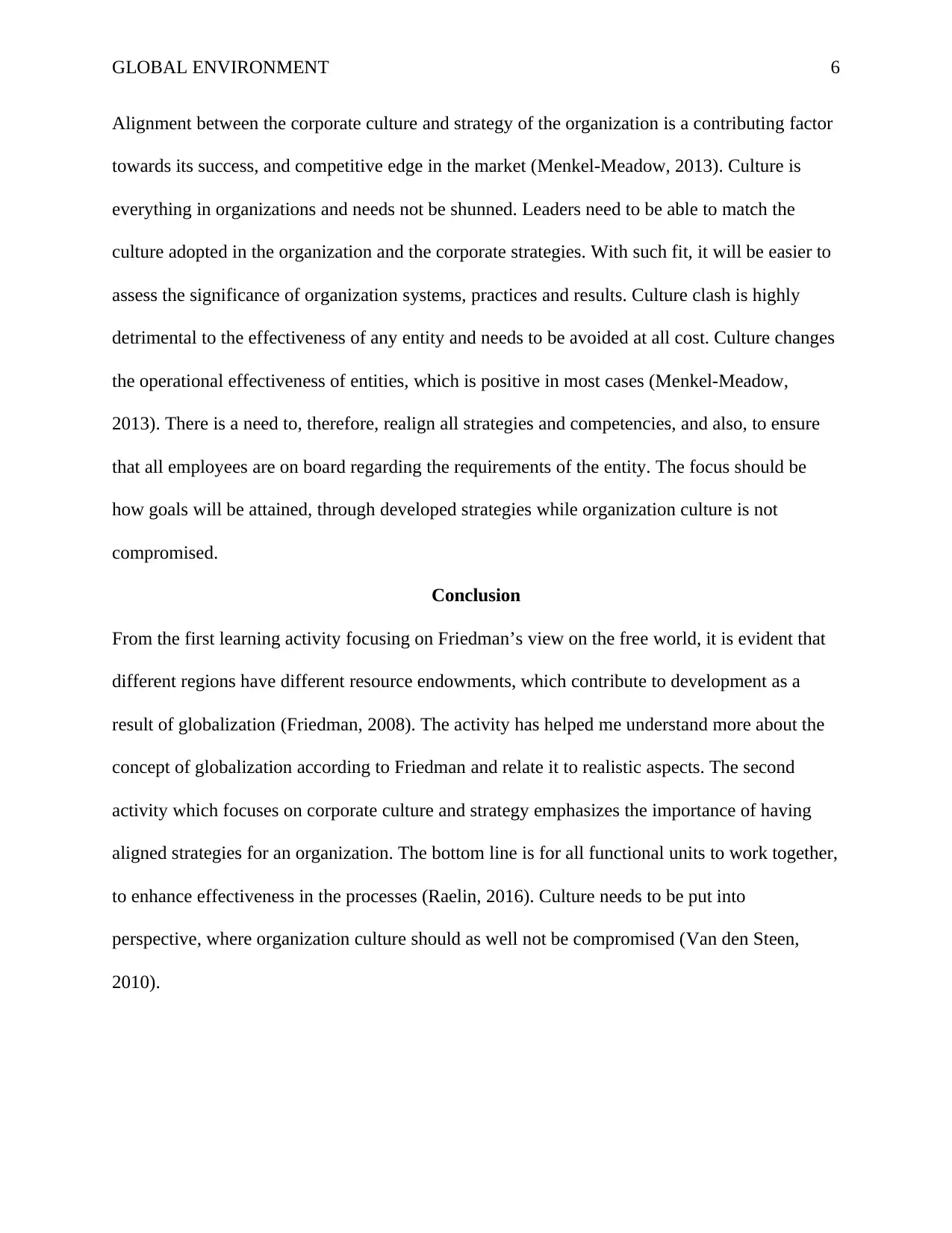
GLOBAL ENVIRONMENT 6
Alignment between the corporate culture and strategy of the organization is a contributing factor
towards its success, and competitive edge in the market (Menkel-Meadow, 2013). Culture is
everything in organizations and needs not be shunned. Leaders need to be able to match the
culture adopted in the organization and the corporate strategies. With such fit, it will be easier to
assess the significance of organization systems, practices and results. Culture clash is highly
detrimental to the effectiveness of any entity and needs to be avoided at all cost. Culture changes
the operational effectiveness of entities, which is positive in most cases (Menkel-Meadow,
2013). There is a need to, therefore, realign all strategies and competencies, and also, to ensure
that all employees are on board regarding the requirements of the entity. The focus should be
how goals will be attained, through developed strategies while organization culture is not
compromised.
Conclusion
From the first learning activity focusing on Friedman’s view on the free world, it is evident that
different regions have different resource endowments, which contribute to development as a
result of globalization (Friedman, 2008). The activity has helped me understand more about the
concept of globalization according to Friedman and relate it to realistic aspects. The second
activity which focuses on corporate culture and strategy emphasizes the importance of having
aligned strategies for an organization. The bottom line is for all functional units to work together,
to enhance effectiveness in the processes (Raelin, 2016). Culture needs to be put into
perspective, where organization culture should as well not be compromised (Van den Steen,
2010).
Alignment between the corporate culture and strategy of the organization is a contributing factor
towards its success, and competitive edge in the market (Menkel-Meadow, 2013). Culture is
everything in organizations and needs not be shunned. Leaders need to be able to match the
culture adopted in the organization and the corporate strategies. With such fit, it will be easier to
assess the significance of organization systems, practices and results. Culture clash is highly
detrimental to the effectiveness of any entity and needs to be avoided at all cost. Culture changes
the operational effectiveness of entities, which is positive in most cases (Menkel-Meadow,
2013). There is a need to, therefore, realign all strategies and competencies, and also, to ensure
that all employees are on board regarding the requirements of the entity. The focus should be
how goals will be attained, through developed strategies while organization culture is not
compromised.
Conclusion
From the first learning activity focusing on Friedman’s view on the free world, it is evident that
different regions have different resource endowments, which contribute to development as a
result of globalization (Friedman, 2008). The activity has helped me understand more about the
concept of globalization according to Friedman and relate it to realistic aspects. The second
activity which focuses on corporate culture and strategy emphasizes the importance of having
aligned strategies for an organization. The bottom line is for all functional units to work together,
to enhance effectiveness in the processes (Raelin, 2016). Culture needs to be put into
perspective, where organization culture should as well not be compromised (Van den Steen,
2010).
⊘ This is a preview!⊘
Do you want full access?
Subscribe today to unlock all pages.

Trusted by 1+ million students worldwide
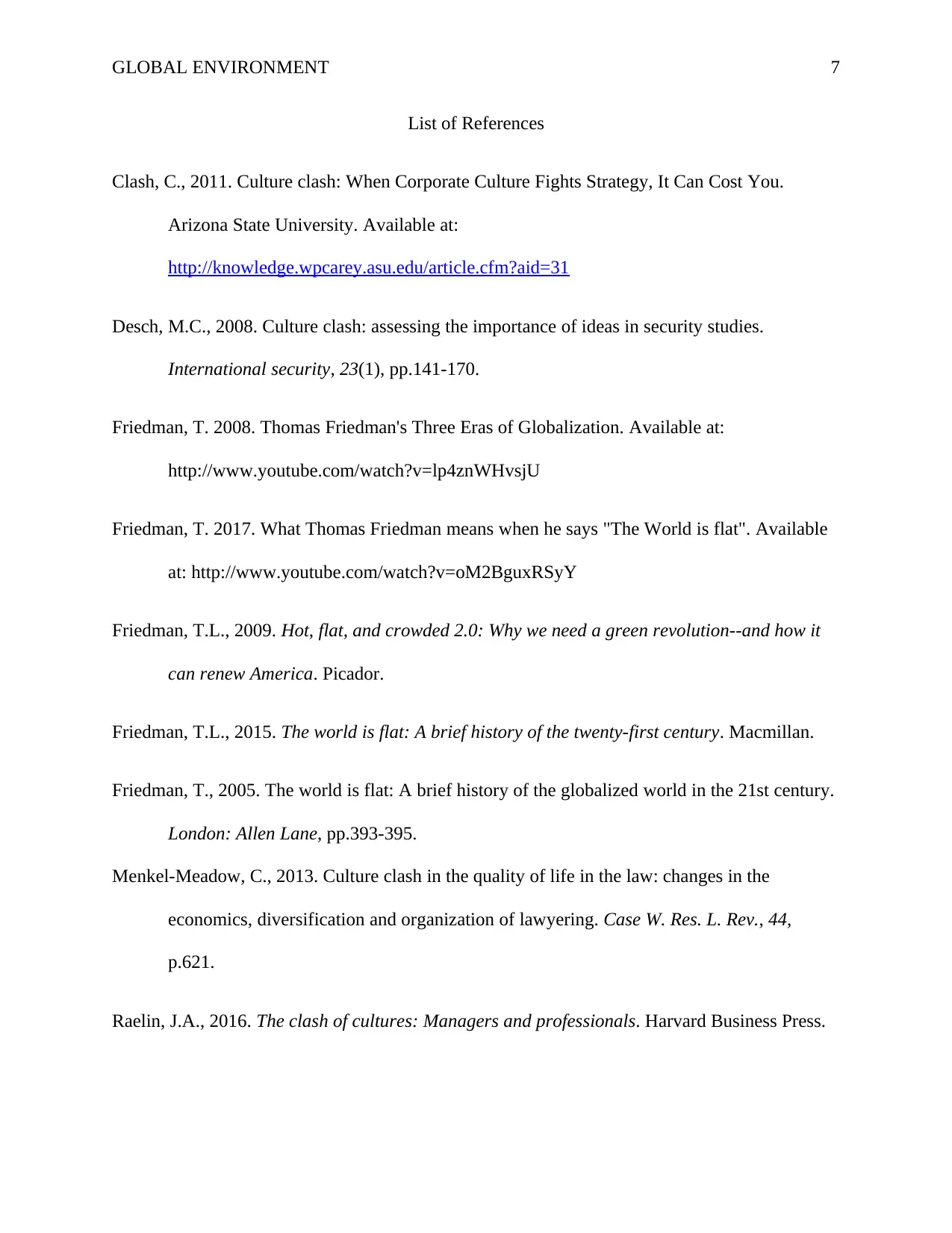
GLOBAL ENVIRONMENT 7
List of References
Clash, C., 2011. Culture clash: When Corporate Culture Fights Strategy, It Can Cost You.
Arizona State University. Available at:
http://knowledge.wpcarey.asu.edu/article.cfm?aid=31
Desch, M.C., 2008. Culture clash: assessing the importance of ideas in security studies.
International security, 23(1), pp.141-170.
Friedman, T. 2008. Thomas Friedman's Three Eras of Globalization. Available at:
http://www.youtube.com/watch?v=lp4znWHvsjU
Friedman, T. 2017. What Thomas Friedman means when he says "The World is flat". Available
at: http://www.youtube.com/watch?v=oM2BguxRSyY
Friedman, T.L., 2009. Hot, flat, and crowded 2.0: Why we need a green revolution--and how it
can renew America. Picador.
Friedman, T.L., 2015. The world is flat: A brief history of the twenty-first century. Macmillan.
Friedman, T., 2005. The world is flat: A brief history of the globalized world in the 21st century.
London: Allen Lane, pp.393-395.
Menkel-Meadow, C., 2013. Culture clash in the quality of life in the law: changes in the
economics, diversification and organization of lawyering. Case W. Res. L. Rev., 44,
p.621.
Raelin, J.A., 2016. The clash of cultures: Managers and professionals. Harvard Business Press.
List of References
Clash, C., 2011. Culture clash: When Corporate Culture Fights Strategy, It Can Cost You.
Arizona State University. Available at:
http://knowledge.wpcarey.asu.edu/article.cfm?aid=31
Desch, M.C., 2008. Culture clash: assessing the importance of ideas in security studies.
International security, 23(1), pp.141-170.
Friedman, T. 2008. Thomas Friedman's Three Eras of Globalization. Available at:
http://www.youtube.com/watch?v=lp4znWHvsjU
Friedman, T. 2017. What Thomas Friedman means when he says "The World is flat". Available
at: http://www.youtube.com/watch?v=oM2BguxRSyY
Friedman, T.L., 2009. Hot, flat, and crowded 2.0: Why we need a green revolution--and how it
can renew America. Picador.
Friedman, T.L., 2015. The world is flat: A brief history of the twenty-first century. Macmillan.
Friedman, T., 2005. The world is flat: A brief history of the globalized world in the 21st century.
London: Allen Lane, pp.393-395.
Menkel-Meadow, C., 2013. Culture clash in the quality of life in the law: changes in the
economics, diversification and organization of lawyering. Case W. Res. L. Rev., 44,
p.621.
Raelin, J.A., 2016. The clash of cultures: Managers and professionals. Harvard Business Press.
Paraphrase This Document
Need a fresh take? Get an instant paraphrase of this document with our AI Paraphraser
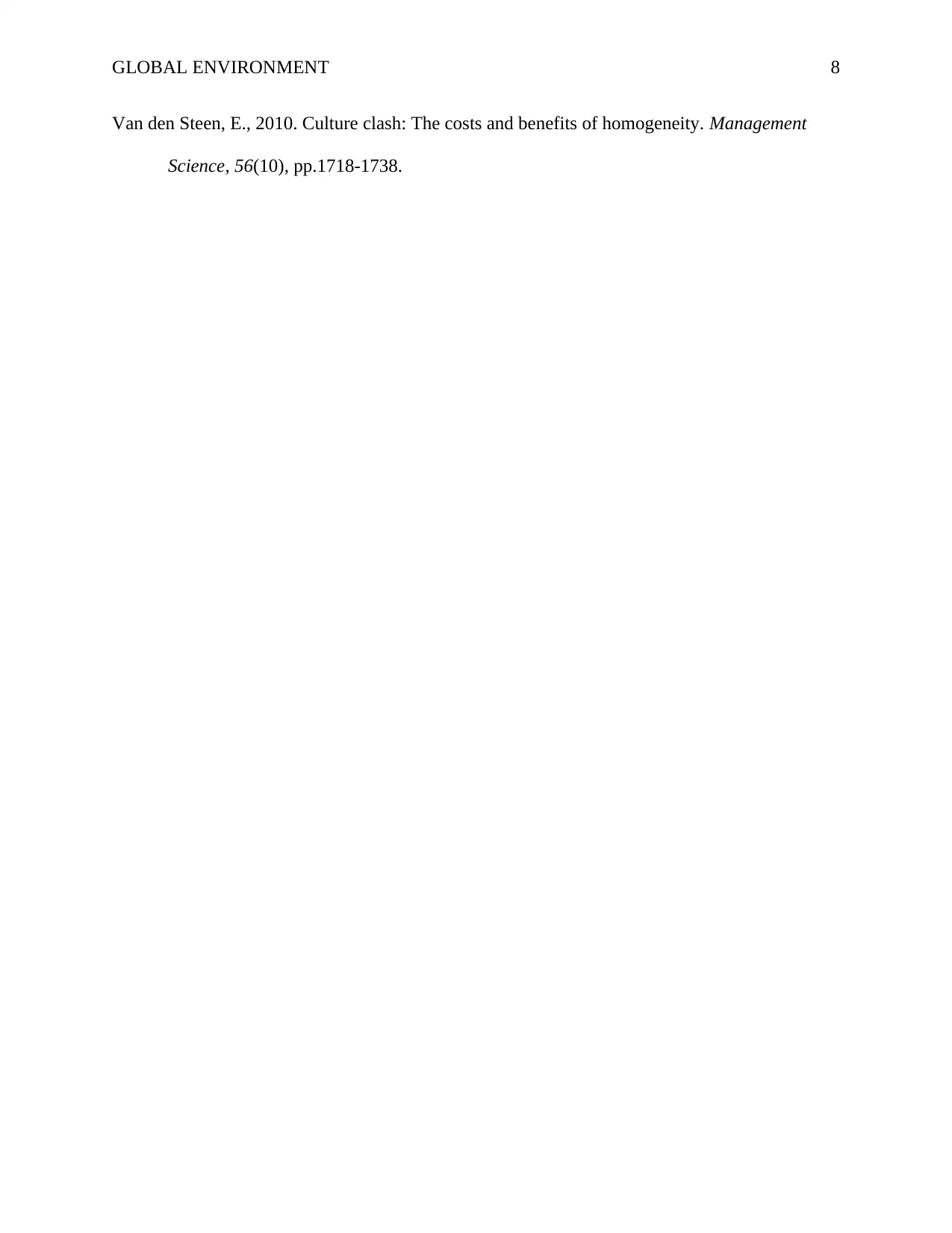
GLOBAL ENVIRONMENT 8
Van den Steen, E., 2010. Culture clash: The costs and benefits of homogeneity. Management
Science, 56(10), pp.1718-1738.
Van den Steen, E., 2010. Culture clash: The costs and benefits of homogeneity. Management
Science, 56(10), pp.1718-1738.
1 out of 8
Related Documents
Your All-in-One AI-Powered Toolkit for Academic Success.
+13062052269
info@desklib.com
Available 24*7 on WhatsApp / Email
![[object Object]](/_next/static/media/star-bottom.7253800d.svg)
Unlock your academic potential
Copyright © 2020–2025 A2Z Services. All Rights Reserved. Developed and managed by ZUCOL.



